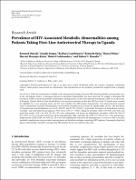Prevalence of HIV-AssociatedMetabolic Abnormalities among Patients Taking First-Line Antiretroviral Therapy in Uganda
Date
2012Author
Omech, Bernard
Sempa, Joseph
Castelnuovo, Barbara
Opio, Kenneth
Otim, Marcel
Mayanja-Kizza, Harriet
Colebunders, Robert
Manabe, Yukari C.
Metadata
Show full item recordAbstract
Introduction. While the introduction of highly active antiretroviral therapy decreased HIV-related morbidity and mortality rates
in the sub-Saharan Africa, a subsequent increase in metabolic abnormalities has been observed. We sought to determine the
prevalence of HIV-associated metabolic abnormalities among patients on first-line antiretroviral therapy (ART) in an ART clinic
in Kampala, Uganda. Methods. Four hundred forty-two consecutive patients on first-line ART for at least 12 months were screened
for eligibility in a cross-sectional study, and 423 were enrolled. Pre-ART patient characteristics were abstracted from medical
charts, examinations included anthropometric measurement and physical assessment for lipodystrophy. Results. The prevalence
of hyperglycemia and dyslipidemia was 16.3% (69/423) and 81.5% (345/423), respectively. Prevalence of dyslipidemia between
stavudine- and zidovudine-based regimens (91% versus 72%; P < 0.001). Being on stavudine (aOR 4.79, 95%, 2.45–9.38) and
peak body weight (aOR 1.44, 95% CI 1.05–1.97) were independent risk factors for dylipidemia. Stavudine (aOR 0.50, 95% CI
0.27–0.93) use was associated with lower risk for hyperglycemia while, and older age (aOR 1.31, 95% CI 1.11–1.56) and having a
family history of DM (aOR 2.18, 95% CI 1.10–4.34) were independent risk factors for hyperglycemia. Conclusions. HIV-associated
metabolic complications were prevalent among patients on thymidine analogue-containing ART regimens. Screening for lipid and
glucose abnormalities should be considered in ART patients because of cardiovascular risks.
Collections
- Research Articles [17]

